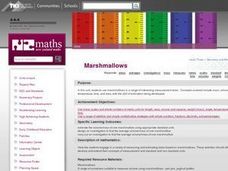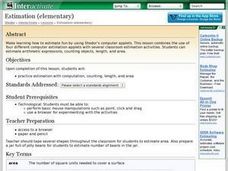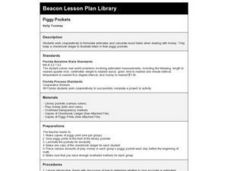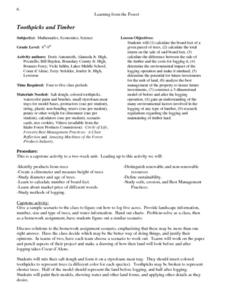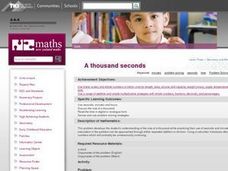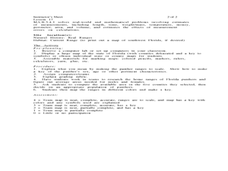Curated OER
Marshmallows
Third graders estimate the volume and mass of one marshmallow using appropriate standard units. They design and carry out an investigation to find the average of volume/mass of one marshmallow.
Curated OER
Paper Packaging Design
Students discuss the relationship between technology and manufacturing. They then use their ideas to construct a model of a paper board carton package. Next they view a PowerPoint presentation to learn about the history of packaging...
Curated OER
Capacity Lotto
In this mathematical worksheet, students convert fifteen metric units of capacity and multiply and divide whole numbers by 10, 100 and 1000.
Curated OER
How Fragile Is an Egg?
Students design a "container" for his/her egg to determine whether the egg remain intact when dropped from a predetermined height.
Curated OER
Estimation Lesson Plan
Students use four different computer estimation applets with several classroom estimation activities.
Curated OER
Learning by Sorting
Students sort Lego Duplo pieces after determining the attributes to classify them by. They work in pairs to sort a group of Duplo pieces and explain their process to others.
Curated OER
Average
In this number averages worksheet, students review how to find the average of a given set of numbers. Students then complete three word problems by averaging numbers.
Curated OER
Houses
Third graders use a number of problem solving strategies in this unit of lessons. They determine how to draw and model three-dimensional objects, use co-ordinate systems, determine probability of events, and identify paths of simple...
Curated OER
Perimeters, Patterns, and Conjectures
Young scholars discover patterns and write conjectures relating to perimeters and polygons. Working in cooperative learning groups, they use manipulatives and graphic organizers to solve problems then answer a series of questions in...
Curated OER
Piggy Pockets
Second graders determine when estimates and exact totals are appropriate in dealing with money. They simulate keeping a checking account over a period of time and keep a checkbook ledger to record deposits and expenses.
Curated OER
Graphing Inertia: An Oxymoron?
Eighth graders investigate Newton's Law of Inertia in order to create a context for the review of the use of different types of graphs. They practice gathering the data from an experiment and put it into the correct corresponding graph.
Curated OER
Worms and more
Students have early length experiences must develop an awareness of what length is, and of the range of words that can be used to discuss length. Young children usually begin by describing the size of objects as big and small. They...
Curated OER
Toothpick Bridges
Students study the techniques of building a bridge. They explore different type of bridges and then plan and build a bridge to specified instructions. Students draw plans, keep a budget, and prepare balance sheets during their bridge...
Curated OER
The One in the Middle
Students review and reinforce the concepts of mean, median, and mode based on the number of siblings the students have. They use Post-it notes to organize and re-organize the data.
Curated OER
Rice (Gohan) Observations
Second graders investigate rice or gohan as it's called in Japan in a couple of experiments. They tally the results.
Curated OER
Toothpicks and Timber
Students problem-solve how to log five acres. Working in pairs, they construct models of logging sites before and after the trees are harvested. they paint their models and include other environmental details.
Curated OER
Trigonometric Applications Outside the Classroom
Fifth graders describe and demonstrate how trigonometry can be used to find the height of a tall building or tree. They describe and demonstrate how trigonometry can be used to find the height of a high hill, or other high object where...
Curated OER
Prints and Outlines
Students determine the area of two objects by superimposing one on the other. They compare and order the area of different shapes by covering a larger shape with similar smaller ones. They complete these activities as different stations.
Curated OER
Visiting Grandma
First graders investigate the aspect of time, including days of the week using a calendar. They use problem solving strategies and a monthly calendar to find a solution to the problem.
Curated OER
A thousand seconds
Students use seconds, minutes, and hours. They then discuss the size of a thousand. After that they read time in digital or analogue form.
Curated OER
Parking Meters
Third graders are introduced to the problem with a short discussion about parking. They then solve with a partner. As they work ask questions that focus on the strategies they are using to make the calculations.
Curated OER
Adam's Watch
Third graders use their watches to tell the time while the teacher lists their responses on the board along with the reasons for them (set incorrectly, gain/lose time). They solve the problem in pairs and focus their thinking on the...
Curated OER
Home on the Range
Young scholars use maps and mathematics to determine the appropriate panther population in a given area. In this Florida ecology lesson, students research the area requirements of male and female panther and use a map to help calculate...
